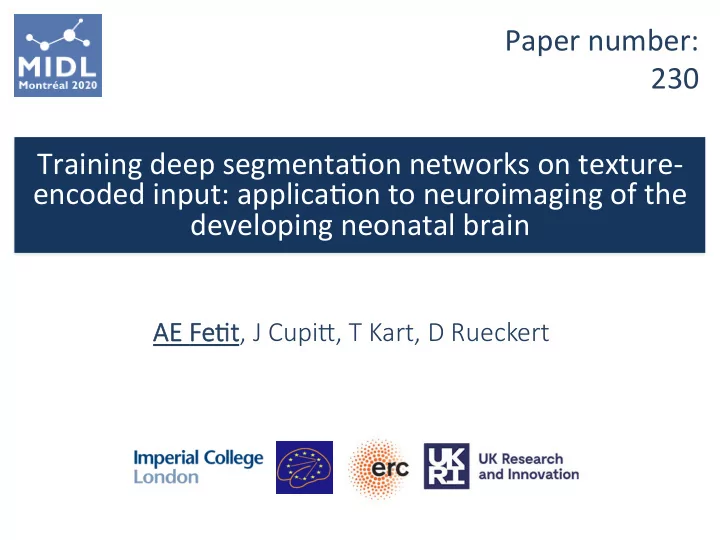

Paper number: 230 Training deep segmenta.on networks on texture- encoded input: applica.on to neuroimaging of the developing neonatal brain AE AE Fe Fe&t, J Cupi., T Kart, D Rueckert
The ‘shape hypothesis’ in deep CNNs ‘cat’ Low-level Mid-level High-level Classifier features features features e.g. lines, e.g. circles, e.g. ears, edges.. triangles.. paws.. Low level shape features are combined in increasingly complex hierarchies un.l the object can be readily classified or detected Work suppor)ng: Zeiler and Fergus, 2014; LeCun et al., 2015; RiOer et al., 2017.
Textural bias in deep CNNs Geirhos et al., 2019.
Segmenta.on of the developing brain with CNNs White Matter Cortical Grey Matter CSF Ventricles Deep Grey Matter
Challenge: Varia.on in both shape and texture 32 weeks 34 weeks 35 weeks 38 weeks 40 weeks
Context: Developmental brain mapping e.g. The Developing Human Connectome Project (DHCP) aims to make major scien&fic progress by crea&ng the first 4D connectome map of early life. It is imp mportant to be.er understand the role of visual texture when developing CNNs on heterogeneous neonatal neuroima maging data.
Our approach: Encoding with local textural paOerns T2-weighted: LBP, 1 pixel: LBP, 10 pixels: Ground-truth:
Experimental set-up Total data To 558, 3D T2-weighted neonatal MRI scans, publicly available by DHCP. Cl Classes es 1. Background, 2. CSF, 3. CGM, 4. WM, 5. Background bordering brain &ssue, 6. Ventricles, 7. Cerebellum, 8. DGM, 9. Brainstem, 10. Hippocampus. Labels Labels Segmenta&on maps available, output of the DHCP structural pipeline. Model-developme ment set 450 for training, PMA 24.7- 42.1 weeks. 20 for valida&on, PMA 27.6 - 42.2 weeks. Held Held-ou -out t tes est se set 88 for tes&ng, PMA 24.3 – 42 weeks. CNN CNN 3D architecture developed with DeepMedic.
CNN architecture • 3D modeling using DeepMedic Kamnitsas et al. 2016. • Three parallel pathways: • normal resolu&on • downsampled by 3 • downsampled by 5 • 8 layers per pathway • Training batch size was set to 5 • Learning rate followed a pre-defined schedule.
Three 3D CNNs 2 3 1 T2-weighted LBP-encoded: LBP-encoded: 1 pixel distance 10 pixel distance The goal is to train CNNs 2 and 3 on explicit textural representations generated from the T2-weighted images, and to evaluate performance in a complex tissue segmentation task.
Summary of results Classes: 1. Background, 2. CSF, 3. CGM, 4. WM, 5. Background bordering brain tissue, 6. Ventricles, 7. Cerebellum, 8. DGM, 9. Brainstem, 10. Hippocampus.
Conclusion The study is the first to show on (neonatal) neuroimaging data that CNNs can indeed be trained on explicit textural representations of the data to achieve segmentation performance that is comparable to models trained on the original T2-weighted scans.
Paper number: 230 Thank you! Questions?
Recommend
More recommend